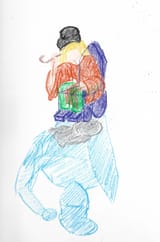Search Results
6/22/2025, 6:58:17 AM
>>49596612
>>49595252
https://en.wikipedia.org/wiki/Tengu
>Buddhism long held that the Tengu were disruptive demons and harbingers of war. Their image gradually softened, however, into one of protective, if still dangerous, spirits of the mountains and forests. Tengu are associated with the ascetic practice of Shugendō, and they are usually depicted in the garb of its followers, the yamabushi.
>It is believed, the term tengu and the characters used to write it are borrowed from the name of a fierce demon from Chinese folklore called tiāngǒu though this still has to be confirmed. Chinese literature assigns this creature a variety of descriptions, but most often it is a fierce and anthropophagous canine monster that resembles a shooting star or comet. It makes a noise like thunder and brings war wherever it falls. One account from the Shù Yì Jì (述異記, "A Collection of Bizarre Stories"), written in 1791, describes a dog-like tiāngǒu with a sharp beak and an upright posture, but usually tiāngǒu bear little resemblance to their Japanese counterparts.
>The Konjaku Monogatarishū, a collection of stories published in the late Heian period, contains some of the earliest tales of tengu, already characterized as they would be for centuries to come. These tengu are the troublesome opponents of Buddhism, who mislead the pious with false images of the Buddha, carry off monks and drop them in remote places, possess women in an attempt to seduce holy men, rob temples, and endow those who worship them with unholy power. They often disguise themselves as priests or nuns, but their true form seems to be that of a kite.
>In stories from the 13th century, tengu began to abduct young boys as well as the priests they had always targeted. The boys were often returned, while the priests would be found tied to the tops of trees or other high places. All of the tengu's victims, however, would come back in a state near death or madness, sometimes after having been tricked into eating animal dung.
>>49595252
https://en.wikipedia.org/wiki/Tengu
>Buddhism long held that the Tengu were disruptive demons and harbingers of war. Their image gradually softened, however, into one of protective, if still dangerous, spirits of the mountains and forests. Tengu are associated with the ascetic practice of Shugendō, and they are usually depicted in the garb of its followers, the yamabushi.
>It is believed, the term tengu and the characters used to write it are borrowed from the name of a fierce demon from Chinese folklore called tiāngǒu though this still has to be confirmed. Chinese literature assigns this creature a variety of descriptions, but most often it is a fierce and anthropophagous canine monster that resembles a shooting star or comet. It makes a noise like thunder and brings war wherever it falls. One account from the Shù Yì Jì (述異記, "A Collection of Bizarre Stories"), written in 1791, describes a dog-like tiāngǒu with a sharp beak and an upright posture, but usually tiāngǒu bear little resemblance to their Japanese counterparts.
>The Konjaku Monogatarishū, a collection of stories published in the late Heian period, contains some of the earliest tales of tengu, already characterized as they would be for centuries to come. These tengu are the troublesome opponents of Buddhism, who mislead the pious with false images of the Buddha, carry off monks and drop them in remote places, possess women in an attempt to seduce holy men, rob temples, and endow those who worship them with unholy power. They often disguise themselves as priests or nuns, but their true form seems to be that of a kite.
>In stories from the 13th century, tengu began to abduct young boys as well as the priests they had always targeted. The boys were often returned, while the priests would be found tied to the tops of trees or other high places. All of the tengu's victims, however, would come back in a state near death or madness, sometimes after having been tricked into eating animal dung.
Page 1
